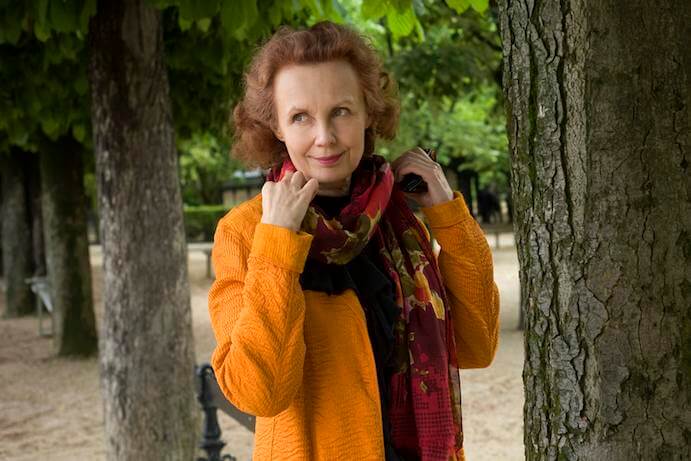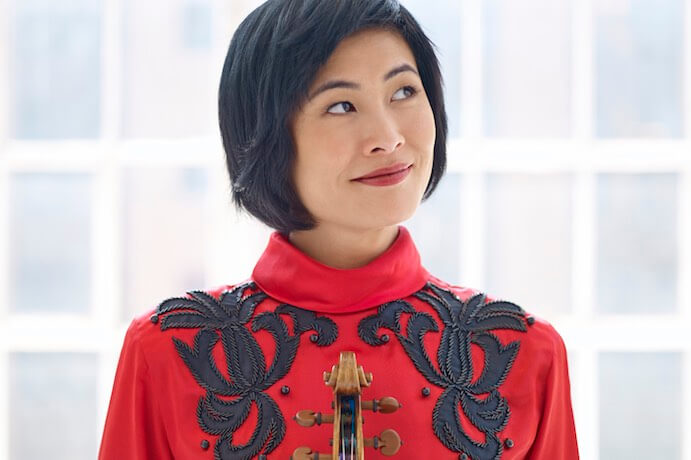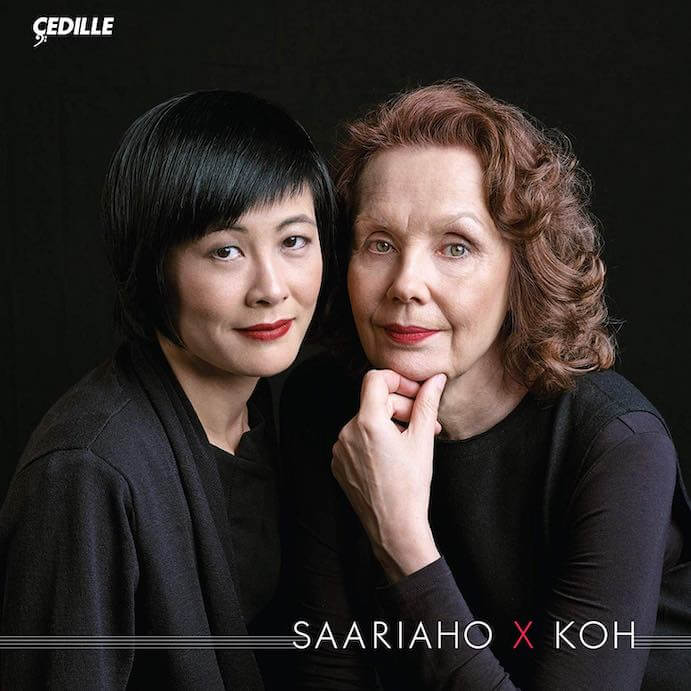The title graphics of this Cedille CD are more than appropriate: it is not titled Saariaho & Koh but Saariaho X Koh. Indeed the two artists’ immense talents are not merely added together–they multiply into a most enjoyable and fascinating program. Violinist Jennifer Koh states that she remembers her first hearing of Kaija Saariaho‘s music and knew immediately she was someone who she could relate to and had to perform.
Saariaho X Koh is hard, concentrated, yet rewarding listening. Much like the music of Morton Feldman, for example, the devil (and delight) in Kaija Saariaho’s music is often in the details. She uses gradual shifts of tone, the inevitable building of tension, and melodic line to create an expressive tapestry. This is not to compare Saariaho directly with Feldman, yet her music gives up its programmatic world subtly, using the definition of subtle, “in a clever and indirect way, in order to achieve something.”
Saariaho X Koh begins with Tocar (2010) for violin and piano. Tocar means “to touch” in Spanish, and is also used as a verb to play an instrument. This is a dark hued toccata, imbued with playfulness and physicality, yet totally devoid of tricky and trendy gimmicks. Saariaho exploits the lyrical aspects of the instruments, as well, while the two different instruments make their way forward independently, leading to a unison climax, then departing in an ambiguous yet satisfying ending. Pianist Nicolas Hodges is a brilliant partner in this fascinating work.

Kaija Saariaho– Photo by Priska Ketterer
Cloud Trio (2009) is a substantial trio for violin, viola, and cello. The four-movement work was inspired by scenes of ever changing clouds in the French Alps. “When you are high in the mountains,” Saariaho explains, “one often sees many different layers of clouds, having all different forms, speeds and textures.” Cloud Trio explores the shifting moods, textures, and sounds of the strings without ever directly evoking clouds. This is not misty impressionism, but a vital and colorful exploration of sound and texture. The fine Hsin-Yun Huang (viola) and Wilhelmina Smith (cello) complete the trio.
Light & Matter (2014)–a substantial single-movement work for violin, cello and piano and the most recent work on the program–receives its first recording on this disc. Inspired by the shifting light in a New York City park, the work begins ominously and darkly in the lower registers of the instruments. Slowly, the trio migrates to brighter light, but still tension-filled and shadowy with foreboding tremolos, sul ponticello passages, and terse rhythms. The work ends much as it began, in a sustained C with all the instruments in unity after going through transformations of light, sound, and color. Anssi Karttunen (cello) and Nicholas Hodges (piano) join Koh in this most atmospheric and darkly rich work.
Aure, a gentile work from 2011, receives its violin and cello version premiere on this disc. Originally for violin and viola, the cello provides a deeper, darker underpinning to the melismatic lines of the violin.”Why us, why the star?” this quote from Anne Frank permeates and inspires this short intermezzo. A high register cello motive at the beginning represents the quote as the violin and cello toss it around like a sound on a gently breezy day. Saariaho packs a lot of emotion and pathos in Aure‘s five minutes, ending with the opening motive in harmonics…like a fading breeze. Short it may be, but Aure is one of the highlights of Saariaho X Koh. Anissi Karttunen on cello joins Koh in this most emotional yet ephemeral performance.

Jennifer Koh–Photo by Juergen Frank
Concluding this generous CD is Graal Theatre (1994). This impressive and vital violin concerto has been recorded several times by top artists and has become one of the composer’s signature pieces. The work was inspired by a book of the same name by Jacques Roubaud. In two lengthy movements marked “Delicato” and “Impetuoso,” Graal Theatre is not a programmatic retelling of the book or the search for the holy grail (although the work has a searching, quest-like quality in its dramatic writing and sound), but rather a musical expression of the act of theatre and the tension between the writer and the actors.
Do I hear the ghost of Bach in the first movement of the work? “Delicato” yes, but also intensely lyrical and contrapuntal as in a Bach solo sonata. The concluding “Impetuoso” is even more dramatic with many passages of fiendish difficulty for both solo and ensemble. The work ends a bit ambiguously, as if the search and the theatre go on forever. Koh’s performance compares favorably with both the Kremer/Salonen on Sony and the Storgards/Lintu on Ondine. If anything, Koh and the outstanding Curtis 20/21 Ensemble under the direction of Conner Gray Covington are more theatrical than the others, as the score demands. Worth the price of admission to program alone!
As one expects from Cedille Records, Saariaho X Koh is a finely engineered disc with informative notes in a slim, attractive package. Seek this one out, you won’t be disappointed! For Saariaho or Koh fans, it is a given that you will want this in your collection.




















